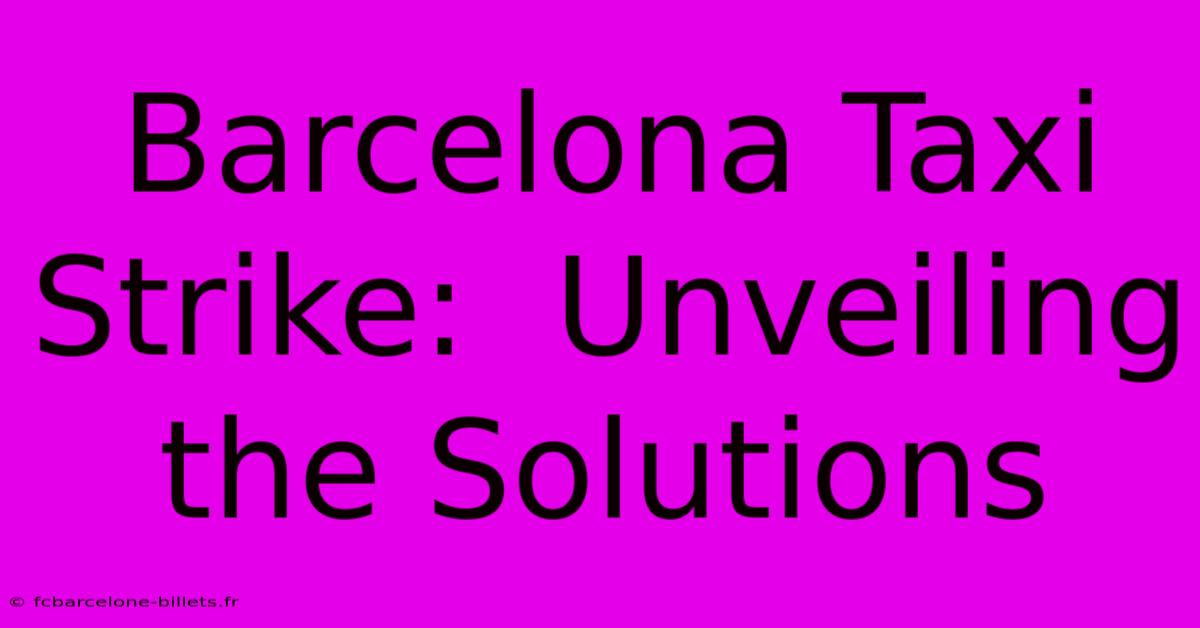Barcelona Taxi Strike: Unveiling The Solutions

Table of Contents
Barcelona Taxi Strike: Unveiling the Solutions
Barcelona's recent taxi strike highlighted deep-seated issues within the city's transportation sector. The disruption caused significant inconvenience for residents and tourists alike, underscoring the urgent need for effective and lasting solutions. This article delves into the root causes of the strike, explores the demands of the taxi drivers, and proposes potential pathways towards a more sustainable and equitable future for Barcelona's taxi industry.
Understanding the Root Causes of the Barcelona Taxi Strike
The Barcelona taxi strike wasn't a spontaneous event; it was the culmination of years of simmering discontent among taxi drivers. Several key factors fueled the unrest:
1. Competition from Ride-Hailing Apps:
The rise of ride-hailing services like Uber and Cabify presented a significant challenge to traditional taxi drivers. These apps often operate with fewer regulations, leading to concerns about unfair competition and a perceived erosion of the taxi industry's livelihood. Drivers argued that the lack of a level playing field undermined their ability to earn a fair living.
2. Licensing and Regulation Issues:
The licensing process for taxis in Barcelona has historically been complex and restrictive, limiting the number of available licenses and contributing to high prices. Taxi drivers argued that this scarcity exacerbated competition from ride-hailing apps and hindered their ability to meet growing demand. Furthermore, existing regulations were seen by some as outdated and inadequate for the modern transportation landscape.
3. Working Conditions and Income Inequality:
Taxi drivers also raised concerns about their working conditions, including long hours, low income, and a lack of social security benefits. The pressure to compete with ride-hailing services while facing high operating costs and limited financial support further intensified these issues. The strike highlighted the need to address income inequality and improve working conditions within the industry.
Analyzing the Taxi Drivers' Demands
During the strike, taxi drivers put forth several key demands aimed at improving their working conditions and ensuring the long-term viability of the taxi industry. These included:
- Stricter regulation of ride-hailing apps: This would involve enforcing stricter compliance with existing regulations and potentially implementing new rules to create a more level playing field between traditional taxis and ride-hailing services.
- Reform of the taxi licensing system: This might include increasing the number of licenses available or simplifying the licensing process to make it more accessible.
- Improved working conditions and social security benefits: This would involve measures to improve drivers' income, provide better health insurance, and address other crucial social security needs.
- Investment in technology and infrastructure: This would involve modernizing the taxi industry through technology upgrades and improvements to infrastructure, enhancing efficiency and customer experience.
Potential Solutions for a Sustainable Future
Addressing the issues raised during the Barcelona taxi strike requires a multi-pronged approach involving collaboration between the city government, taxi drivers, and ride-hailing companies. Here are some potential solutions:
1. Collaborative Dialogue and Negotiation:
Open and honest dialogue between all stakeholders is crucial. Establishing a platform for regular discussions can help foster understanding, address concerns, and prevent future conflicts.
2. Balanced Regulation of Ride-Hailing Services:
Implementing fair regulations that consider the interests of both traditional taxi drivers and ride-hailing companies is essential. This requires carefully balancing the need to promote competition with the need to protect the livelihoods of taxi drivers.
3. Modernizing the Taxi Industry:
Investing in technology, such as mobile payment systems and improved dispatch systems, can improve efficiency and customer experience. This can also help taxi drivers compete more effectively with ride-hailing apps.
4. Improving Working Conditions and Social Security:
Implementing measures to improve drivers' income, provide better social security benefits, and address issues like long working hours is crucial for ensuring the well-being of taxi drivers.
5. Public Awareness Campaigns:
Highlighting the contributions of taxi drivers to the city and the importance of supporting local businesses can help foster public goodwill and promote a more positive image of the taxi industry.
The Barcelona taxi strike served as a stark reminder of the need for a more sustainable and equitable transportation ecosystem. By addressing the root causes of the unrest and implementing the solutions outlined above, Barcelona can create a future where both taxi drivers and passengers benefit from a more efficient, reliable, and fair transportation system. The ongoing dialogue and collaboration between all parties are crucial for achieving this goal.

Thank you for visiting our website wich cover about Barcelona Taxi Strike: Unveiling The Solutions. We hope the information provided has been useful to you. Feel free to contact us if you have any questions or need further assistance. See you next time and dont miss to bookmark.
Featured Posts
-
Asa Barcelona Taste The Flavors Of Catalonia
Apr 03, 2025
-
2011 12 Barca Kit Show Your Colors
Apr 03, 2025
-
Barcelonas Quirky Shops Find Something Unique
Apr 03, 2025
-
Barcelona To Montserrat A Stress Free Day Trip
Apr 03, 2025
-
Geneva To Barcelona Train Compare Prices And Book Now
Apr 03, 2025
